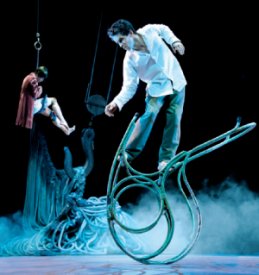Circus performers
Rachel Clare of Circus Front tells Anna Goodman about her views on audience development in contemporary circus and its potential place as an artform in the UK.
 Crying Out Loud is a London-based company producing, commissioning and programming performance with UK and international artists for audiences of all ages. A priority for Crying Out Loud is to produce circus, having maintained strong links with circus-related arts for many years.
Crying Out Loud is a London-based company producing, commissioning and programming performance with UK and international artists for audiences of all ages. A priority for Crying Out Loud is to produce circus, having maintained strong links with circus-related arts for many years.
One of our main challenges is to change the public’s perception of contemporary circus, which is so much more than Cirque Du Soleil. It’s important to understand that just as the term ‘physical theatre’ covers a broad range of work, so does the term ‘contemporary circus’. What makes circus arts different? In essence, it involves the mastering of skills, and then crucially what you do with those skills within a theatrical context. For example, companies like Collectif AOC (one of 2007’s main acts at Circus Front) and James Thiérrée, who performed recently at Sadler’s Wells, have the inclination and imagination to combine elements of circus and dance to create unique productions that have changed people’s perceptions of the boundaries between circus and theatre.
Audience development can only take place once there has been a radical shake-up of how circus is perceived. The role, or potential roles, that circus may have within the arts must be redefined. Our society’s cultural acceptance of circus is linked to its profile and where it is positioned within the cultural framework. For example, one reason that circus has such a high profile in France is because of its 12 circus schools designed to prepare youngsters to enter the four-year degree-equivalent course. There is also a National Network of 11 organisations called ‘Pôles Cirque’, which are a combination of venue and production centres with resident artists. They present circus shows all the year round, and usually organise a festival every year. The Pôles have a wide educational and creative remit including running workshops for professionals and students. They also work together to co-produce shows that go on to tour France.
The idea of children and young people going to a circus school in France is as common as ballet in the UK. We shouldn’t be worried about crossing boundaries. With physical theatre, hip-hop dance and martial arts the training is very isolated, but artists working within circus are merging them together to create increased access. The teaching of skills such as break-dancing could increase training opportunities for young people by combining this with the teaching of circus skills. It doesn’t all need to happen in specific centres such as Circus Space. It could happen in any sports hall. In the UK there is a change of attitude as Circus Space and Circomedia in Bristol develop BTech and degree courses.
Circus Front is a season of contemporary circus that includes the broadest possible picture of what’s going on internationally: installations, late night cabaret, shorter mixed bills as well as the main house performance. This year there were four main house shows alternating over a period of seven weeks. It came about because of the Roundhouse’s desire to be the home of circus in London. Crying Out Loud has positioned large-scale circus within main auditoriums in London, for example ‘Easter Delirium’ at Southbank Centre and ‘The Catch’ at The Lyric, Hammersmith. Verity McArthur invited me to join her to develop a new way of thinking about, programming and commissioning circus performance, as joint artistic director of Circus Front.
We have a number of approaches to developing new audiences for Circus Front. About four years of research went into developing the best possible programme. We created a funky yet thoughtful brand identity for the whole festival, but then tapped into audiences for particular art forms for certain shows. The decision to call it Circus Front came about because we wanted an umbrella title to the season. The word ‘Front’ suggested that we were doing something ‘in-Front’, ‘up Front’, it had ‘Front’, we were ‘Fronting’ a new wave of work, and it was a shop ‘Front’ that people could look into.
The success of the festival was in the programming of such diverse and innovative work, showing both audiences and practitioners the potential within the art form. In order to consolidate the successes, the Roundhouse is committed to programming a biennial Circus Front season. The emphasis will be on commissioning new and challenging British work that can compete with European contemporaries. The next season will be during Easter 2009.
The other invaluable element is the continuing development of the link between the Roundhouse studios with their educational learning activities – making young people practitioners rather than merely spectators – and the events in the main space. One day – who knows? – there might be 70 or 100 circus schools in England.

Join the Discussion
You must be logged in to post a comment.